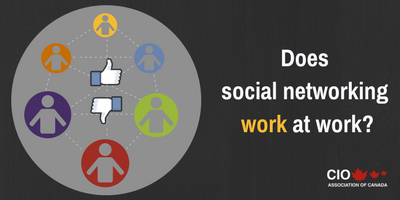Social media is something we’ve all become accustomed to in recent years. Facebook, Twitter, Instagram and Snapchat are a few of these applications used by millions around the world in their personal lives. But what is the real definition of Social Media? Google’s top answer is: “Websites and applications that enable users to create and share content or participate in social networking.” Many hours of our personal lives have been spent on these platforms, with users reporting various levels of satisfaction. What about the workplace? Could the benefits of social networking become a valuable resource for employees? It is worth considering some of the pros and cons of social media at work.
In many organizations, internal social media platforms are being rolled out for employees to use. At an enterprise level or a business level social media provides an entirely new dimension to the workplace. The business use of social media can connect individuals from different locations, facilitating collaboration and virtual resololution to any number of issues. In a project team, five, ten or fifteen brains can come together to solve a problem. What are the possibilities of having an entire company work together to solve a problem through one post?
Despite the exciting potential, for some companies the risks can easily outweigh the return of having these networks in place. If an organization does decide to implement an internal social media application, finding the network that fits their business size is a major factor to consider. The business purpose is another variable to factor in. There are many providers and options available to choose from, each with their own distinctive services, features and functionalities. Yammer, Zimbra, Slack, and Clarizenare some examples of household social networks used by businesses today. Of these examples, Yammer is an enterprise level network, like Facebook, with the ability to create different groups, statuses and the capability to communicate with all members of the organization. For smaller businesses, Yammer wouldn’t be the ideal choice, but an instant messaging application such as Slack would be more beneficial. Each organization has different needs; some will not need the functionality of these specific applications. If there is no expressed need, then is there a reason to consider implementation of a social tool?
Here are some of the pros and cons of internal social media applications at work
Organizations are slowly shifting to a more digital and unbureaucratic environment and these applications can serve as an easy and carefree form of communication organization wide. Employees can feel comfortable sharing ideas, collaborating, solving problems and even networking with others through this channel. In a large organization, the executive team of senior leaders can use this medium to connect with employees and eliminate the barriers of communication. Other advantages include:
• Allowing employees to discuss ideas, post news, ask questions, share links and remove departmental silos
• Employees can broaden contacts in the company by connect with people from various departments
• Ease of targeting audiences for information sharing and eliminating unnecessary emails
• Ability to expand research, implement marketing campaigns and foster creativity
As social media has its disadvantages in our personal lives, in an organization these drawbacks will persist. Security concerns and the governance of using social media are big issues any company would need to face. There must be a plan in place to mitigate the impact of any hacks or virus attacks. In terms of governance the organization would need to figure a way to leverage these applications to suit the business. This tailoring work may not prove beneficial in the long run. There are many obstacles and barricades that can impede successful implementation and sustainablity of the application. Other negative implications include:
• Potential for employees posting negative comments about other employees or the organization
• Employees misusing the applications with illicit and offensive materials
• Risk of spreading scams and viruses by sharing hyperlinks and information through the Internet unintentionally
• Possibility of spending many work hours on these applications
What do you think about having social media applications at your workplace? Has your company adopted one of these networking platforms? Do you have a success or horror story to share? Please comment and share your thoughts.
 Keerthan (Keith) Sivanesan recently completed his commerce degree in Business Technology Management at Ted Rogers School of Management, Ryerson University. He is interested in both the Business Analysis and Project Management fields and loves volunteering for the CIO association.
Keerthan (Keith) Sivanesan recently completed his commerce degree in Business Technology Management at Ted Rogers School of Management, Ryerson University. He is interested in both the Business Analysis and Project Management fields and loves volunteering for the CIO association.
